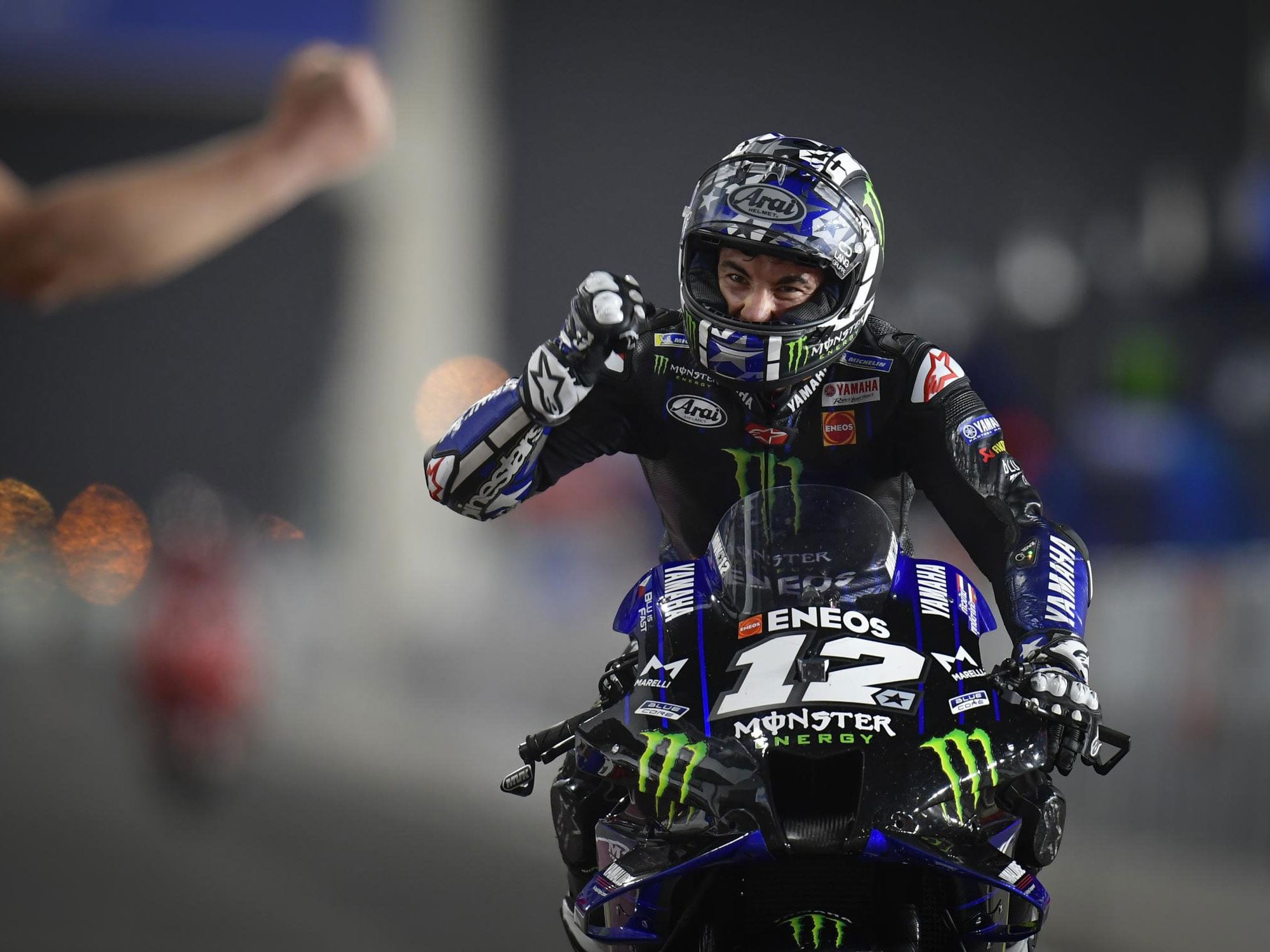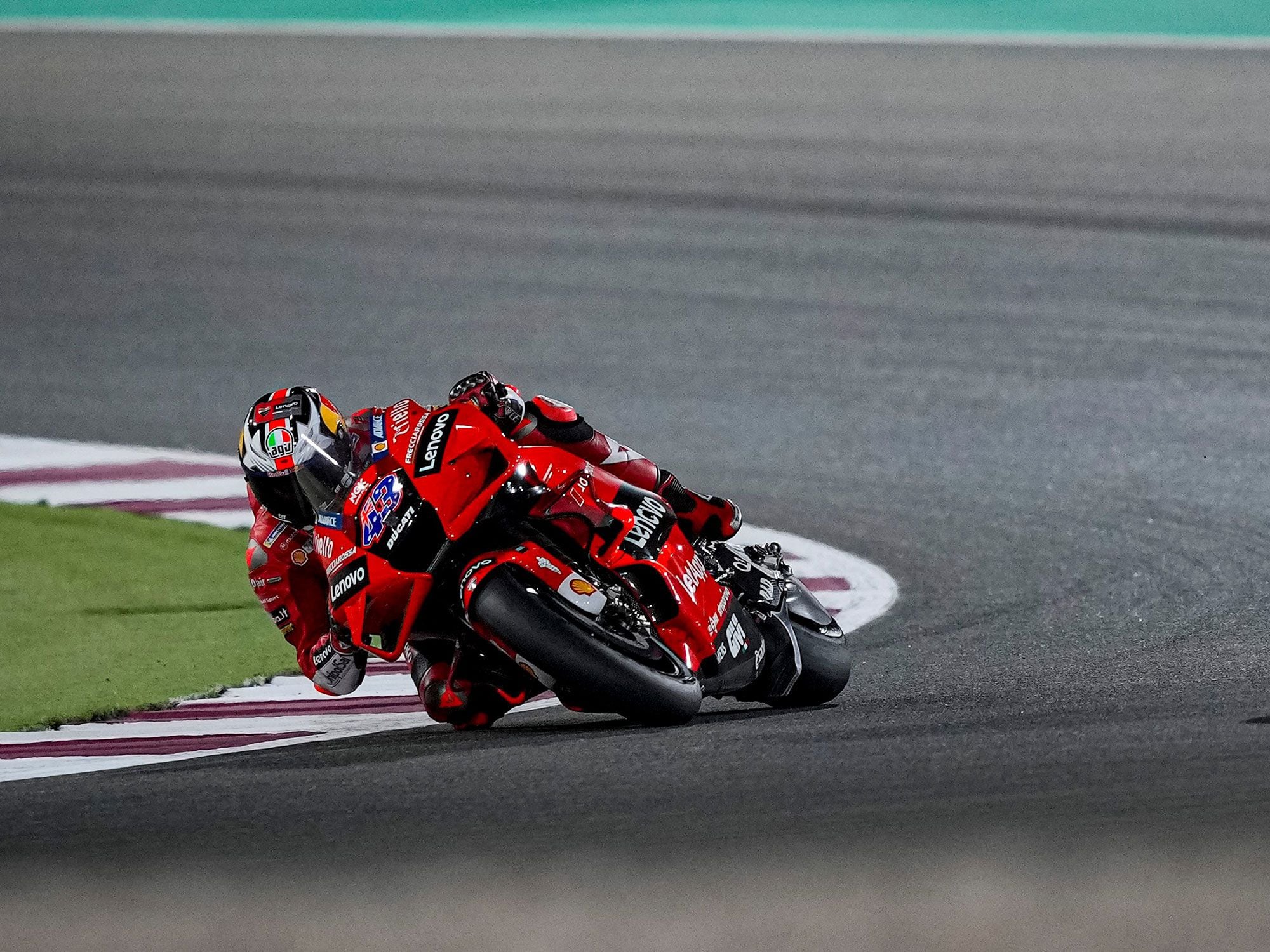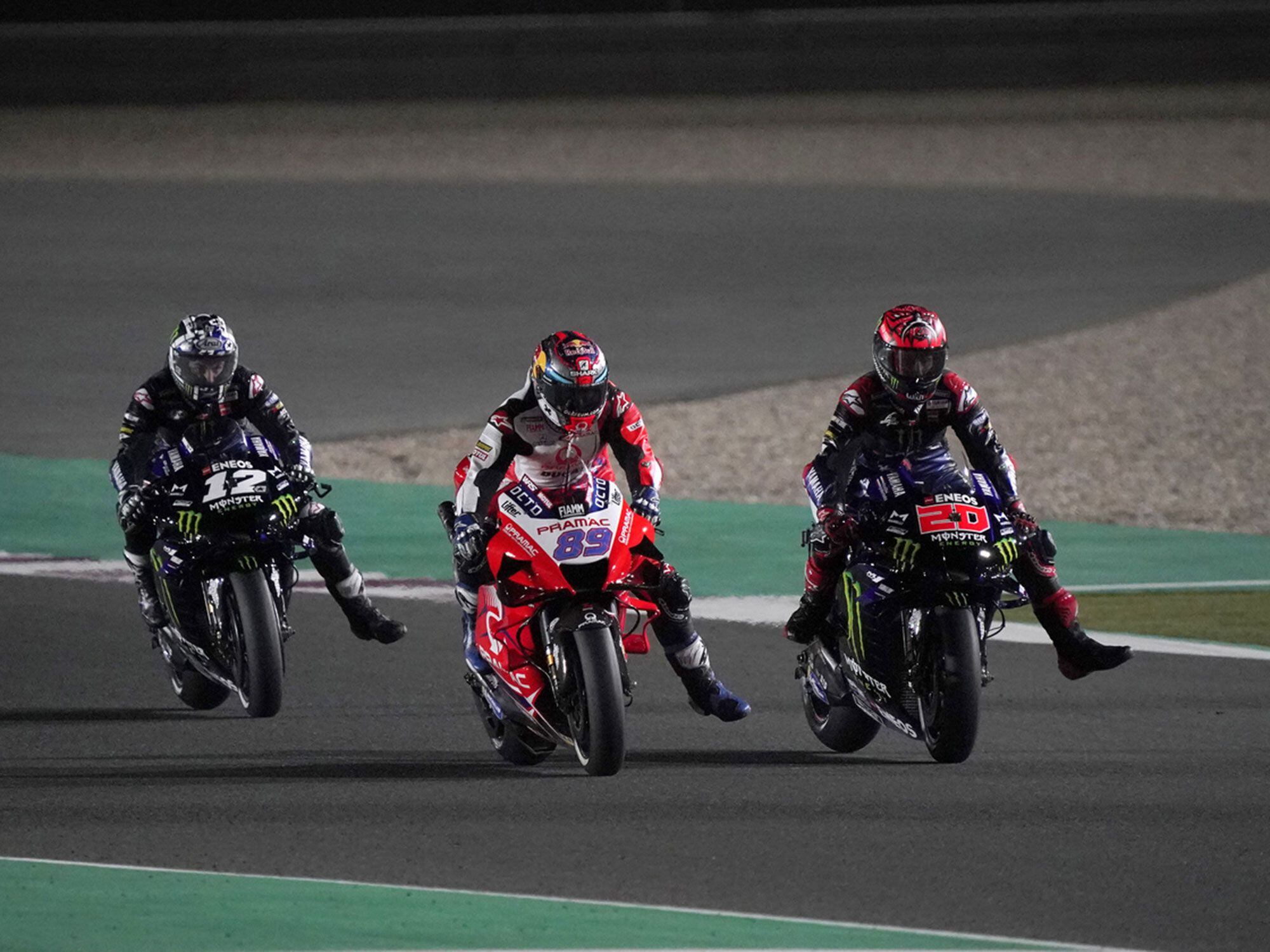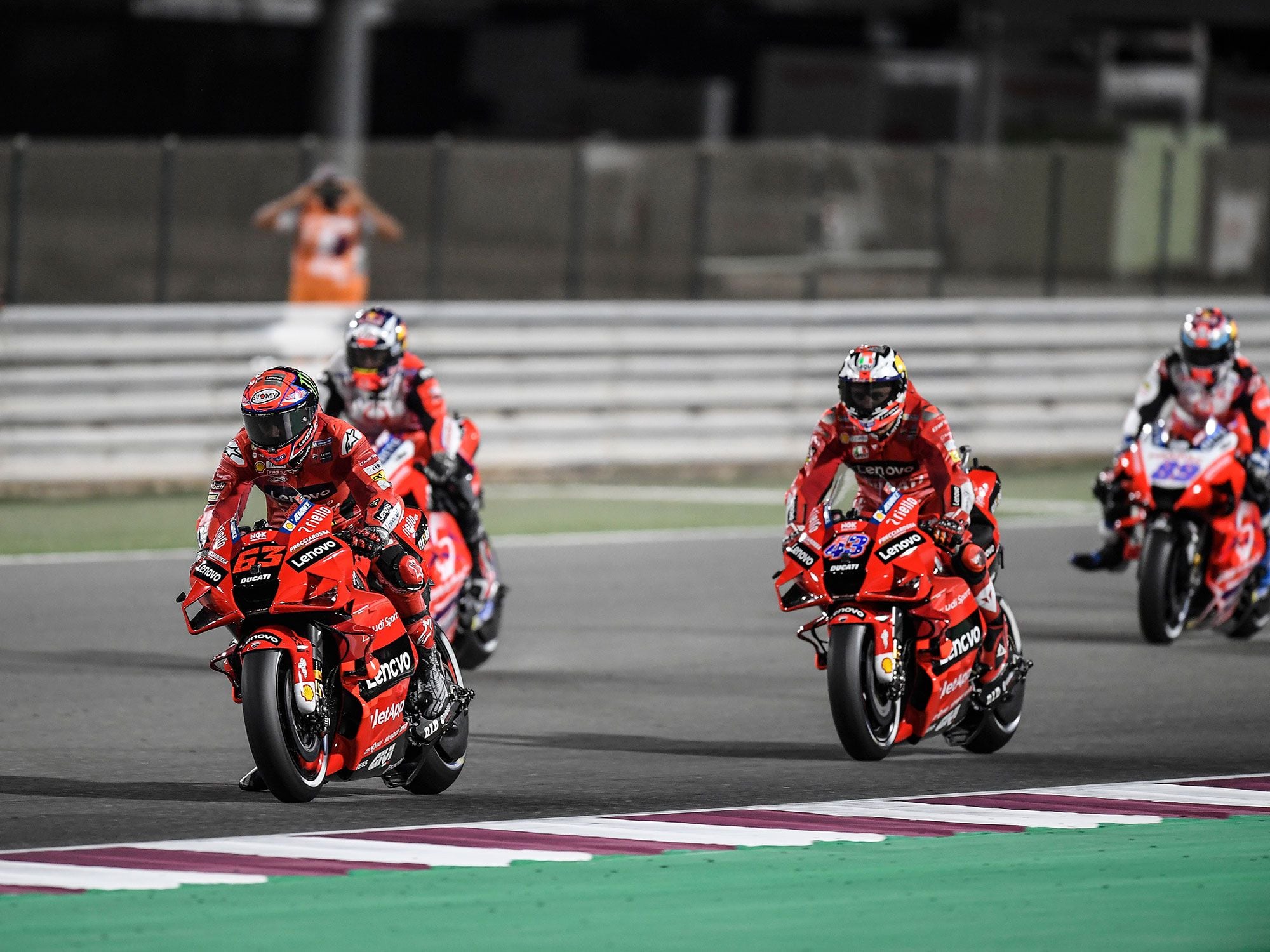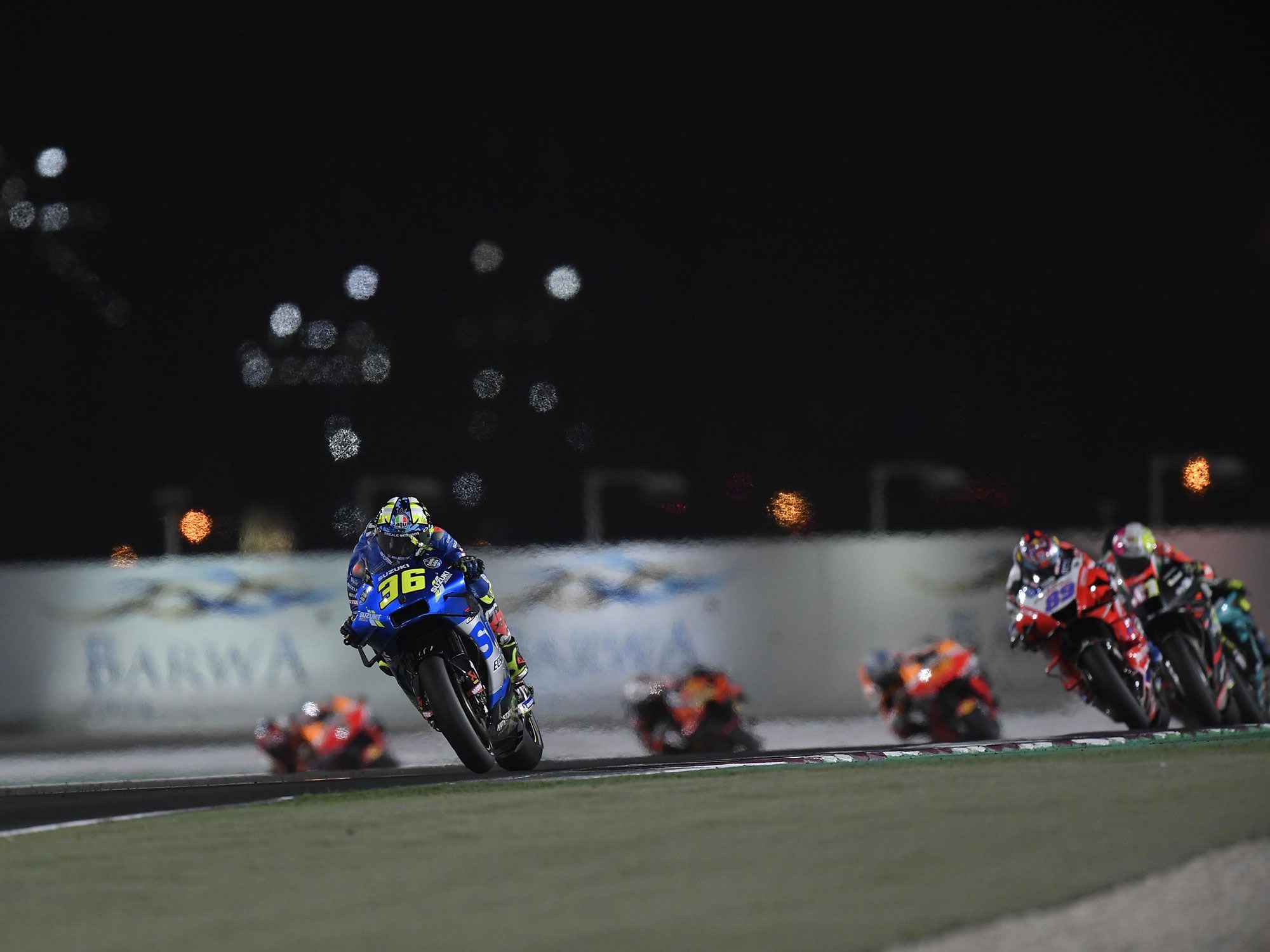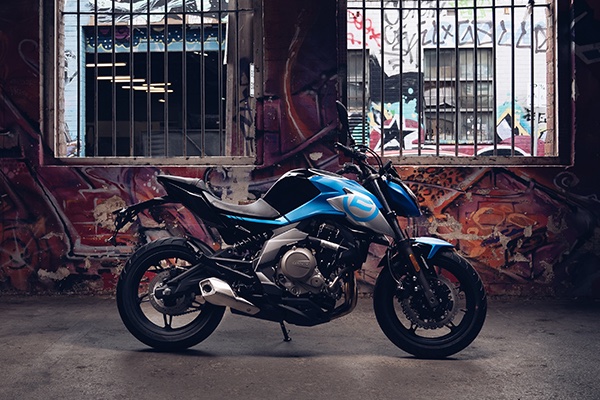Maverick Viñales takes the first MotoGP of 2021. (MotoGP/)Maverick Viñales has won the first MotoGP event of 2021 on a Yamaha, in a well-planned and well-managed weekend. The Ducatis were impressively fast (Andrea Dovizioso won this event on Ducati in 2018 and 2019) and at the start, their front-and-rear-lowering holeshot device and great power put them 1-2-3-4 by turn 2. One of their riders—first-timer Jorge Martin on a Pramac Ducati—came from 14th starting position.
Viñales said, “Actually (my) start didn’t go so well—I had a lot of wheelies.
“After that I felt the potential, I was taking everything with calm and saving the tires for a good moment.
“Finally I opened a gap and I was trying to control the tire and manage the power.”
Yamaha, at the start of recent seasons, has shown promise only to return to its recent reputation for lacking tire grip in the last third of races. Yamaha team management had on Saturday expressed the view that the Ducatis, although very fast through practice, would be unable to use their power in the second half. So it turned out.
Francesco Bagnaia, pole-sitter on factory Ducati, led the race for 14 laps while the usual deck of tire surprises was dealt. He would finish third. He noted in practice, “Yamaha is very strong in sector two and three but we can close the gap in sector four with our top speed. The balance is very close.”
So it would turn out, with Viñales winning by just 1.092 second over Johann Zarco’s Pramac Ducati.
Jack Miller, Ducati factory star of practice and the favorite, was third for five laps before tire problems moved him back to finish ninth.
“We had a really good start and were able to push as I liked, not too hard in the beginning, but when Viñales came past (on lap 8) I thought, ‘Now it’s time to start upping the pace,’” Miller said. “But then bang, I hit a wall and started losing the rear on the midcorner.”
Jack Miller started strong, but rear tire issues saw him dropping positions after lap 5. (Ducati/)In the five days of preseason testing, Miller had been very upbeat about the 2021 Ducati. Asked to explain this, he said, “Just my confidence I feel in the front end… How I’m really able to let the brakes off and let the bike…roll and carry some decent corner speed.”
Corner speed—the very thing that former factory Ducati rider Dovizioso had been asking for over several years—midcorner grip.
Miller continued, “I haven’t really had that confidence in this thing ever, and especially through the faster corners, 12, 13, 14, 15, just letting the brakes off and really letting the bike hook in and turn. It feels fantastic.”
Riders have to be able to accept the highs like this, and also the terrible moments when they realize the tire is fading and nothing can be done about it.
Behind early leader Bagnaia were Zarco and Fabio Quartararo (factory Yamaha). Quartararo said, “I was feeling so strong in the beginning of the race.
“But then I noticed a big drop in the rear tire, which we didn’t expect because I didn’t have that during the test or the practice sessions.”
That would eventually drop him from third (from lap 6 to lap 10) to a fifth-place finish.
Fabio Quartararo finished fifth while also battling a loss of rear tire grip. (Monster Energy Yamaha/)Zarco said, “In the moment (when) Maverick could lead he had this strong advantage in second and third gear… So in second and third he was gaining on us.”
In other words, despite the power of the Ducatis, Viñales’ Yamaha had rear grip when they had not.
And what about 42-year-old Valentino Rossi, lately moved from Yamaha factory status to the Petronas satellite team? Through practice he was hardly noticed, but bang, he qualified fourth.
Franco Morbidelli said of this, “…he showed he can never be trusted and that he is always ready to surprise. I was practically always in front (of him) both in the tests and in free practice, but today, when it counted, he was faster.”
Rossi in the race would be relegated to 12th.: “After a few laps in the race,” he said (never higher than seventh, he slowed after lap 9), “I was struggling with the tires. Unfortunately this had already happened during the tests, with the rear. For some reason it seems like I stress it a lot, so it loses performance.
“Strange, because it was colder.”
The other Petronas Yamaha rider, Morbidelli had a mechanical failure that was attended to on the grid but immediately sent him to the rear once the race started:
“Basically the rear end of the bike starts to feel empty, like I have no damping in the shock.”
Speculation pointed to Yamaha’s version of the “holeshot” starting device, which lowers only the rear in order to raise the bike’s acceleration “wheelie limit” for the start. At present Ducati, Honda, Aprilia, and KTM have holeshot devices that lower both ends of the bike. Suzuki’s system lowers only the front.
Ducati’s holeshot device was effective, putting four Ducatis at the front on the start. (Ducati/)What about Suzuki, which in the hands of Joan Mir last year displayed such consistency that he was able to become world champion, having won only one GP? The Suzukis raised no eyebrows through practice, but in the race Mir started 10th and had moved up to sixth by lap 6, then held station until lap 14 when he again advanced.
“I finally found the sensations of last season on the bike,” Mir said.
“I tried to manage the tires as best I could and then push in the final part.”
By lap 20 (of 22) he was third and looking like a podium finisher. Having passed Zarco for second, he then lost time in taking a wider line off the last turn, last lap.
“At the last corner I tried to widen to get more speed at the (beginning) of the straight, but it didn’t help much. I expected one Ducati in the sprint (to the line) but Bagnaia was there all the time.”
With no more need to conserve rubber, the Ducatis smoked Mir to the line and his tantalizing podium evaporated.
Joan Mir pushed from a tenth-place start and moved to second on the last lap, but the Ducatis of Johann Zarco and Pecco Bagnaia powered past on the front straight relegating Mir to a fourth. (Ecstar Suzuki/)Dear reader, I am sorry to have to show racing as the crapshoot it so often is, but with tires now looking a lot more like luck than like science, even the most experienced of riders rolls those rubber dice with little more chance of getting it right than a first-year novice.
On the other hand, it was Viñales who came the closest to figuring out the tires this time. In FP2 he ran four sessions, two with soft/medium and two with the eventual universal choice, soft/soft. The results said soft/soft. In FP3 he did eight consecutive laps on hard/hard, the best four being one minute 55 seconds—not so hot. Then in FP4 he ran ten laps, six of them in the minute-54s. Other riders were as fast but none as consistent. There isn’t time in practice for a thorough study of the tire problem, but some can get a glimmer—maybe enough knowledge to be useful
Fortunately everyone gets a second chance at the windswept and sandy Losail circuit in Qatar next Sunday.
And in case you didn’t know, Marc Márquez is sitting out these two Qatar GPs to be sure his arm is properly healed but is expected on the grid at Portugal’s Algarve International Circuit, weekend of April 18.
Just for fun, let’s consider just two novelties now available to the rubber compounder, whom I have always imagined as living atop a mountain and wearing a tall conical hat adorned with purple stars.
First is an instrument that now enables trackside measurement of tire tread rubber hysteresis. It basically vibrates a small hemispherical piston that is pressed against the tread, and software derives information from it, quantifying one of the basic mechanisms of rubber friction.
Second is a possible substitute for the classical sulfur cross-links between rubber chains that Charles Goodyear used to transform a sticky glop into a durable elastic solid. Goodyear’s method comes down to us as “vulcanization” or “curing” of rubber.
Not all of the elastic polymer chains that make up rubber consist of identical molecules, joined end to end. Some consist of blocks of different kinds of molecules, and are called “block copolymers.”
What if we add a small number of a kind of polymer that bonds strongly to itself? A short string of those in one rubber chain could line up with and stick to others of the same kind in an adjacent chain, cross-linking them in a manner similar to that of the usual sulfur bonds.
Let’s imagine further that this polymer that we add, in bonding selectively to its own kind, displays behavior very like a melting point. Get rubber made this way a little too hot and the chain-to-chain bonds weaken and separate.
What could we do with this material? We might not want to rely entirely on this form of cross-linking, but could supplement it with some traditional sulfur bonds. When this rubber reached a certain temperature, our trick copolymer blocks would let go of each other, causing the rubber to lose whatever of its properties depended on their form of cross-linking.
Could we, in this way, make tires that slow down the faster riders, making racing more “exciting” for spectators? I’m sure that a rubber compounding chemist could, if he or she were free to speak openly, entertain us endlessly with such possibilities.


